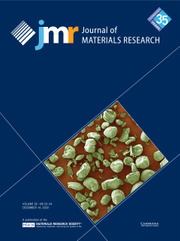Crossref Citations
This article has been cited by the following publications. This list is generated based on data provided by Crossref.
Liu, L. M.
Wang, S. Q.
and
Ye, H. Q.
2003.
First‐principles study of metal/nitride polar interfaces: Ti/TiN.
Surface and Interface Analysis,
Vol. 35,
Issue. 10,
p.
835.
Chiu, Chia-Hsiang
and
Lin, Chien-Cheng
2008.
Formation mechanisms and atomic configurations of nitride phases at the interface of aluminum nitride and titanium.
Journal of Materials Research,
Vol. 23,
Issue. 8,
p.
2221.
Wu, W. L.
2010.
Dissolution precipitation mechanism of TiC/Ti composite layer produced by laser cladding.
Materials Science and Technology,
Vol. 26,
Issue. 3,
p.
367.
Sha, Zijie
Douglas, James O.
Yedra, Lluís
Seymour, Ieuan D.
Estradé, Sònia
Peiró, Francesca
Skinner, Stephen J.
and
Kilner, John A.
2024.
Revealing Local Grain Boundary Chemistry and Correlating it with Local Mass Transport in Mixed‐Conducting Perovskite Electrodes.
Small,
Vol. 20,
Issue. 50,

